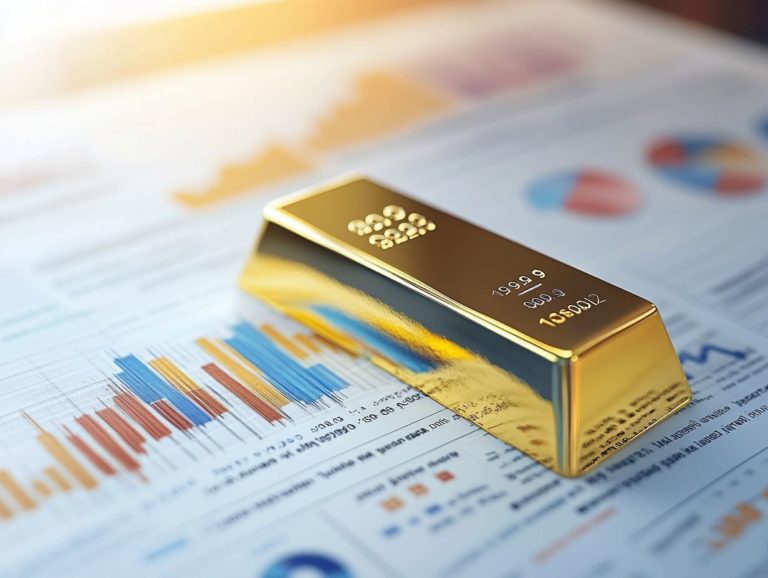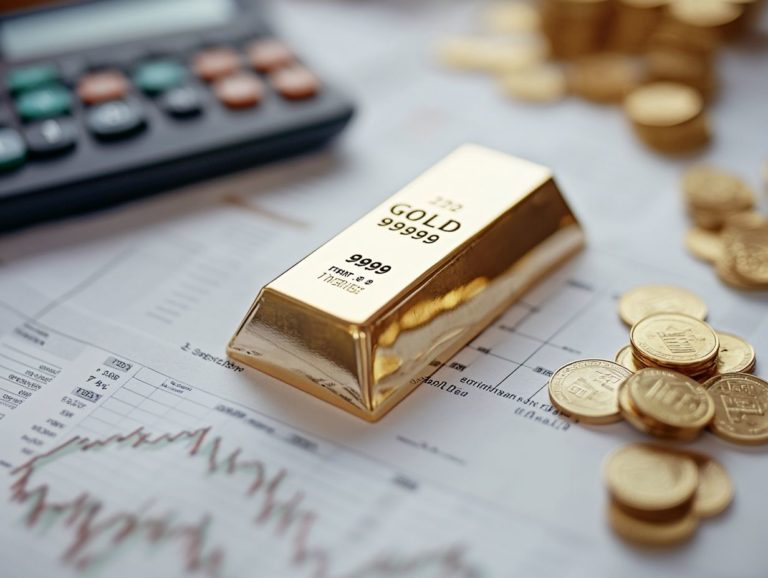The Role of Central Banks in Gold Markets
Central banks hold a pivotal position in the financial landscape, particularly in gold markets. Their historical ties to gold as a reserve asset and current strategies for managing gold holdings significantly influence economic stability and the dynamics of gold prices.
You will discover the evolution of central banks’ relationship with gold, their current reserves, and how their policies impact gold prices. You will also gain insights into what the future may hold for this vital asset. Dive in as you uncover the connections between central banks and gold, revealing crucial insights for both investors and policymakers alike.
Contents
- Key Takeaways:
- History of Central Banks and Gold
- Current State of Central Banks’ Gold Holdings
- Impact of Central Banks on Gold Prices
- Central Banks’ Gold Policies and Strategies
- The Future of Central Banks’ Role in Gold Markets
- Trends and Predictions for Central Banks’ Gold Holdings and Influence
- Frequently Asked Questions
- What is the role of central banks in gold markets?
- Why do central banks hold gold reserves?
- How do central banks impact the price of gold?
- Do all central banks hold the same amount of gold?
- What is the history of central banks and gold markets?
- Can central banks manipulate the price of gold?
Key Takeaways:

- Central banks, as the monetary authority of a country, play a crucial role in the gold market through their gold holdings and policies.
- Central banks’ actions and decisions can significantly impact gold prices, making them key players in the overall financial market.
- The future of central banks’ role in gold markets is evolving, with potential changes in gold holdings and strategies as global economic and political landscapes change.
Defining Central Banks and Their Role in Financial Markets
Central banks are pivotal institutions that manage a country’s monetary policy, regulate financial stability, and oversee currency issuance. They play a critical role in shaping global liquidity and impacting the economy through interest rates and various monetary tools.
With their significant influence in financial markets, central banks, such as the US Federal Reserve and the People’s Bank of China, are key players in the gold market, particularly regarding gold demand, reserves management, and the role of speculation in gold prices.
These institutions implement strategies that can either stimulate or cool down economic activity based on current conditions. By adjusting interest rates, they directly influence borrowing costs, investment decisions, and even spending habits.
Their decisions ripple through international markets, as changes in monetary policy can lead to fluctuations in exchange rates. Central banks also carry the responsibility of safeguarding the economy against inflation or deflation, ensuring a stable financial environment for everyone.
Their role extends to being significant purchasers of gold, which reflects their strategies for diversifying reserves and protecting against currency devaluation. Understanding the role of precious metals in a portfolio further solidifies their influence on both domestic and international economic landscapes, ultimately shaping the financial world.
History of Central Banks and Gold
The relationship between central banks and gold has undergone a remarkable transformation over the years, especially during the gold standard era when currencies were directly linked to gold reserves. This connection profoundly influenced the global financial system and played a crucial role in maintaining economic stability.
Evolution of Central Banks’ Relationship with Gold
This shift is crucial, driven by rising market volatility, geopolitical tensions, and the unpredictable behavior of fiat currencies. Central banks have gradually shifted their stance on gold accumulation, moving away from a rigid reliance on gold as a monetary base to a more nuanced approach that acknowledges gold’s vital role in ensuring financial stability.
In response to these challenges, these institutions are seeking refuge in the tangible value that gold offers. By strategically enhancing their gold reserves, central banks are not just amassing a traditional safe haven; they are also recalibrating their monetary policies to cultivate a more resilient framework against economic downturns.
The implications of this shift are significant. The increasing allocations towards gold holdings reflect a fundamental reassessment of asset management and risk mitigation in today’s uncertain financial environment.
Current State of Central Banks’ Gold Holdings

As of the first quarter of this year, central banks globally have showcased a significant trend toward increasing their gold reserves. This move reflects a burgeoning demand for gold as a safe-haven asset, particularly in light of economic uncertainties and geopolitical tensions.
Explore how these shifts in central banks’ gold strategies can impact your investment decisions today!
Top Central Banks and Their Gold Reserves
Among the world s leading central banks, the People’s Bank of China, Central Bank of Turkey, and Reserve Bank of India are top players in gold reserves, showing a shift toward gold accumulation for better financial security and market stability.
These institutions use various strategies to increase their gold holdings. For instance, China has made significant strides, raising its reserves to approximately 2,000 tons, making it one of the largest holders of gold worldwide. Turkey has also been proactive, acquiring over 500 tons recently to strengthen its economic position amid geopolitical tensions.
India’s Reserve Bank has drawn attention by purchasing gold to stabilize the currency and fight inflation, reflecting a broader trend among central banks to diversify their assets. This collective accumulation highlights a transformative shift in investment strategies, focusing on tangible assets in an increasingly volatile global market.
Impact of Central Banks on Gold Prices
The actions of central banks significantly influence gold prices. Their monetary policies and strategic purchases can trigger fluctuations in market volatility, affecting investors and the broader financial landscape.
Understanding this interplay can help you navigate the complexities of the investment world more effectively.
How Central Banks’ Actions Affect Gold Markets
Central banks’ gold buying activities have a powerful impact on gold markets, often triggering immediate reactions and shaping overall performance as you, the investor, respond to shifts in central bank policies.
When a central bank, such as the European Central Bank or the People’s Bank of China, decides to increase its gold reserves, it sends a clear signal to the market: these institutions see gold as a safe haven during uncertain economic times.
This behavior boosts demand and creates a positive outlook among investors. The psychological effect is noteworthy; as news of these purchases spreads, more investors may be drawn to gold, anticipating further price surges.
Central bank actions can reshape supply dynamics, especially when large quantities are taken off the market. This reinforces perceptions of scarcity and helps elevate prices even further, highlighting the role of central banks in precious metals.
Central Banks’ Gold Policies and Strategies

Central banks’ gold policies and strategies are crucial for maintaining financial stability and promoting a well-rounded approach to asset management. By incorporating diversification strategies, they reduce the risks associated with volatile markets, ensuring a more resilient financial landscape.
Reasons for Holding Gold and Diversification Strategies
Central banks hold gold for several important reasons, viewing it as a key diversification tool, a safeguard against economic instability, and a geopolitical diversifier that enhances financial security.
Gold s intrinsic value, recognized across various cultures throughout history, establishes it as a trusted asset in turbulent times. When faced with economic challenges such as soaring inflation or volatile currencies central banks often rely on gold as a dependable store of value. This precious metal acts as a buffer, providing a reassuring sense of security amid uncertainty.
As central banks carefully manage their portfolios, incorporating gold not only complements their fiat currency holdings—money that a government has declared to be legal tender—but also bolsters their overall financial resilience. Understanding the role of precious metals in a tax-efficient portfolio enables them to navigate diverse economic landscapes more effectively.
The Future of Central Banks’ Role in Gold Markets
The future role of central banks in gold markets is set for change, driven by ongoing global demand for gold, shifts in monetary policy, and an increasing recognition of gold’s intrinsic value as a safe haven during uncertain times.
Trends and Predictions for Central Banks’ Gold Holdings and Influence
As you look ahead, it’s clear that trends suggest central banks are likely to keep increasing their gold holdings, especially in emerging markets aiming to bolster their financial stability and influence within the global economy.
This strategic shift highlights a wider appreciation for gold’s historical role as a safe-haven asset during times of economic uncertainty. Emerging economies are seizing the opportunity to strengthen their reserves, and understanding gold’s role in a portfolio could change the global financial landscape profoundly!
These economies often face greater vulnerability to currency devaluations and geopolitical tensions. Hence, there is a significant drive to enhance their reserves with tangible assets.
Analysts propose that the rising demand for gold from these nations could significantly reshape the global financial landscape. Central banks diversify their portfolios to reduce risks associated with paper money. The implications are profound, hinting at a potential shift in the balance of power within the international monetary system. This includes understanding the role of gold in retirement planning.
Frequently Asked Questions

What is the role of central banks in gold markets?
Central banks play a crucial role in gold markets as they are responsible for managing a country’s monetary policy and maintaining financial stability. This includes buying, selling, and holding gold reserves as part of their overall foreign exchange reserves.
Why do central banks hold gold reserves?
Central banks hold gold reserves for various reasons, including as a store of value and as a hedge against inflation and currency fluctuations. Gold also serves as a form of international liquidity, allowing central banks to settle international transactions and support their currencies. This versatility makes gold an essential asset for many countries.
How do central banks impact the price of gold?
Central banks can influence the price of gold through their buying and selling activities, as well as through changes in interest rates and financial rules. When central banks buy gold, it can increase demand and drive up prices, while selling can have the opposite effect.
Do all central banks hold the same amount of gold?
No, the amount of gold reserves held by central banks varies greatly from country to country. Some central banks, such as the United States and Germany, hold significant amounts of gold, while others may hold very little or none at all.
What is the history of central banks and gold markets?
Gold has played a significant role in the global economy for centuries, and central banks have been involved in gold markets since their inception. In the past, gold was used as the primary backing for currency, and central banks were responsible for maintaining the gold standard. While this is no longer the case, gold remains an important asset for central banks.
Can central banks manipulate the price of gold?
There is ongoing debate about whether central banks can manipulate the price of gold. While central banks do have the power to influence gold prices, they are limited in their ability to control them due to the large and global nature of the gold market. Central banks typically focus more on maintaining overall financial stability rather than manipulating specific asset prices.















